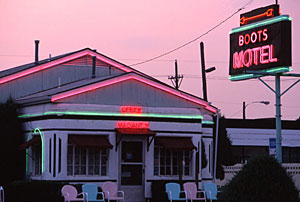 Boots Motel along Route 66 in Carthage, Missouri Photo: Courtesy Jim Ross/National Trust for Historic Preservation |
The National Trust for Historic Preservation released its 2007 list of America’s 11 Most Endangered Places today. It includes everything from individual buildings, such as the abandoned Brookline, Massachusetts, residence of the 19th century architect H.H. Richardson, to entire landscapes threatened by the construction of new power transmission lines in seven Mid-Atlantic states. Since initiating the list of Endangered Places in 1988, the Trust has successfully worked to save 52 percent of sites from destruction.
A few of the places on this year’s list also appeared on the World Monuments Fund’s 2008 Watch List of 100 Most Endangered Sites, released last week. They include historic structures along Route 66, and internment camps that the U.S. government used to hold Japanese citizens during the Second World War—Topaz, Utah, in the case of the World Monuments Fund, and the Minidoka camp in Jerome County, Idaho, in the case of the National Trust.
“The sites on this year’s list of America’s 11 Most Endangered Historic Places embody the diversity and complexity of America’s story, and the variety of threats that endanger it,” Richard Moe, the National Trust’s president said in a statement accompanying today’s announcement. “The places on this year’s list span the continent and encompass the breadth of the American experience. Each one is enormously important to our understanding of who we are as a nation and a people.” The complete text of the list follows below.
|


Post a comment to this article
Report Abusive Comment